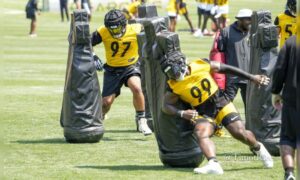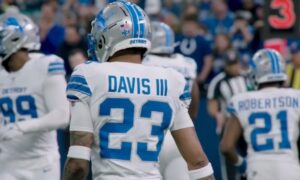A lot of discussion, understandably, has been had in recent years about the fact that the Pittsburgh Steelers have seen not one, or even two, but three legitimate starters emerge for the team in their rookie season this year. A large part of that discussion pertains to the fact that they have all come on the defensive side of the ball.
The Steelers are indeed fortunate to see their rookie draft class find so much success this year, which is more than they can say about—well, most of them in their history, or at least their recent history. All three of them emerged not by necessity, but by being the best player at their position.
That’s not to say that they didn’t have some semblance of a loose plan in the works. The selections of cornerback Artie Burns in the first round, safety Sean Davis in the second, and defensive tackle Javon Hargrave in the third, were hardly coincidental in hitting three areas of need on the side of the ball that most needed improvement.
And it can probably be said that they helped coax along their young rookies into the starting lineup, at least a little bit. In Davis’ case, he ended up starting in the slot in large part due to injury, but Burns eventually took over that role, and then, gradually, the starting spot. That wasn’t a major transition because he was already playing outside in the nickel anyway, which is their base defense.
Overall, however, it should not be ignored that, while the talent of this rookie class is obviously a major component in their emergence into the starting lineup, the fact that the defense simply is no longer stocked with talent is perhaps the biggest catalyst for their rapid ascendance.
In fact, we have seen young rookies with pedigree ready enter the starting lineup relatively early. Bud Dupree was active in his playing time immediately and took over the starting job by the end of the year in 2015. Ryan Shazier opened the 2014 season as a starter, and Stephon Tuitt finished the year starting. In 2013, Jarvis Jones was given the reigns to start for a long stretch of the season.
Only Tuitt’s role could be argued to have been influenced by injury, but he did not replace an injured starter; rather, he leapfrogged the current starter when the rotational player who was seeing more time anyway went down.
It was much harder for, say, Jason Worilds in 2010 to fight for a starting spot than it was for Jones or Dupree, as he was playing behind James Harrison and LaMarr Woodley. Lawrence Timmons didn’t crack the starting lineup until his third season because they had veterans James Farrior and Larry Foote.
Cameron Heyward, even, waited until the fifth game of his third year to start, because they still had talent in the pipeline in front of him.
Hargrave filled the void left by Steve McLendon. Davis replaced Robert Golden, who never established himself as a full-time starter. And Burns entered a cornerback room that was, shall we say, severely depleted. They are starting because they are the best players on the team to start. But unlike other rookies in the past with high pedigree, they also had the opportunity laid out in front of them.








